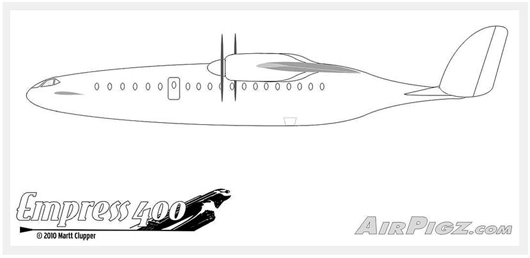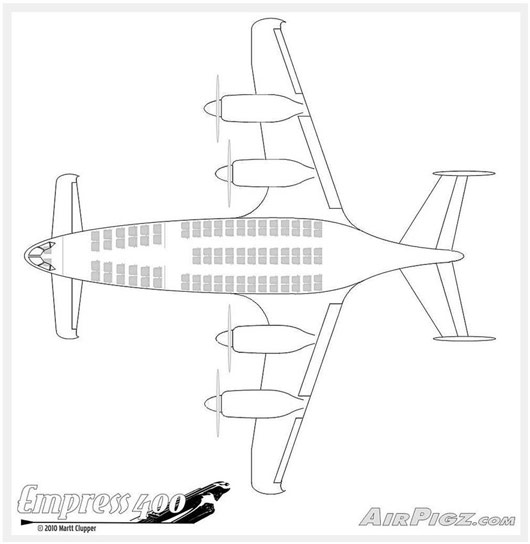Retro Airliner Design Contest: Design #1 - The Empress 400
 Thursday, April 8, 2010 at 11:49PM
Thursday, April 8, 2010 at 11:49PM 
Here's submission #1 for the AirPigz Retro Airliner Design Contest... it's the Empress 400, from me! She's a bit radical, with a little bit of old and a little bit of new. Powered by 4, 4,000hp new technology radial engines, she has 100 seats and cruises at a nice round 400 mph. As you can see, I've incorporated the 3LSC (3 Lifting Surface Configuration) into the design, similar to the Piaggio P180 Avanti.
I'll post more detail soon so you can get a better idea of all the thoughts I've tossed into this Ruler of the Sky, but for now you can check out the 4 drawings that I put together.
I only got one other submission in the contest, and I'll get that posted tomorrow so we can have a poll to determine the winner of the Retro Airliner Design Contest : )



 Martt |
Martt |  8 Comments |
8 Comments | 













































































Reader Comments (8)
Oooohhh, I love the design, a nice blend of retro with The new school, very nice. :)
Something I just noticed - that's an awfully big bird to have just a single set of mains. Anything with 16k horsepower will probably be pretty heavy and that could lead to a lot of blown tires.
It's very unusual though, in a good way. I think it'd be a lot of fun to get to fly on one.
m_lorenger- thanx, yours looks good too! I'll get it posted tomorrow.
Adam- All 3 gear legs have 2 tires, side by side, you just don't see that in the drawings : )
From what I understand, the primary reason the Piaggio Avanti uses three surfaces are structural.
Piaggio enginers wanted to route the main wing spar aft of the pressure vessel and had to add a small lifting surface (near the nose) to balance lift.
Your airliner would only have the advantage of routing the aft wing spar (spar that carries flap and aileron loads) aft of the pressure vessel.
The main wing spar might still limit head room in the aft cabin.
Rob- It's true that the main spar would still interrupt the cabin area to some extent, but again, the idea is to have it as far aft as possible to minimize the intrusion.
My P180 research indicates that the primary purpose of the 3 surfaces is to have them all lifting, with no down force created as traditional tails have. The down force only works against the airplane in terms of efficiency, which helps to explain why the Avanti is the world's fastest (and likely most efficient) turboprop. The P180 link in this post gives more info and resources on this.
Dear Martt, your assertion that the Avanti is the fastest turboprop is incorrect. The great Russian airliner of the 1950's-60's, the Tupolev Tu-114, derivatives of which are still in service today in military form as the Tu-95 Bear, set a world speed record for turboprop airliners (and other turboprop aircraft) which still stands today, of over 540 mph. The Avanti can manage a mere 460 mph. Creditable for a plane with only 1200 eshp, when compared with the Tu-114, each of whose four engines produced nearly a staggering 15,000 eshp - the most powerful turboprops ever by a wide margin.
Pittock- You're right, but what I meant in saying 'turboprop' was: a business aircraft powered by jet engines swinging props. I'll try to watch my details better in the future : )